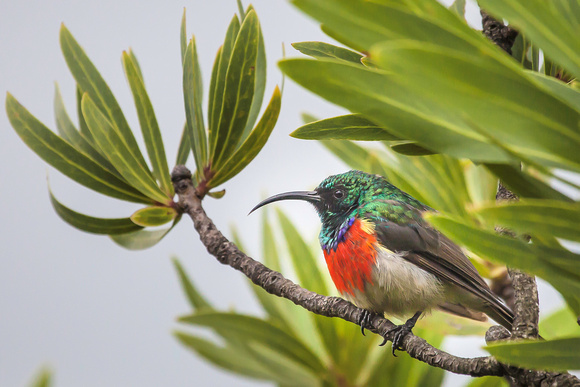Greater Double-collared Sunbird (Cinnyris afer)
Greater Double-collared Sunbird (Cinnyris afer)
6 inches long.
The sunbird breeds mainly in South Africa and Swaziland, but is also found in the mountains of Angola, Congo, Rwanda and Burundi. It is common in gardens, fynbos, forest edges and coastal scrub. It is usually found in mountainous or hilly country.
The sunbird is usually seen singly or in pairs. Its flight is fast and direct on short wings.
It lives mainly on nectar from flowers, but takes some fruit, and, especially when feeding young, insects and spiders. It has the habit of hovering in front of webs to extract spiders. It can hover like a hummingbird to take nectar, but usually perches to do so.
The sunbird breeds all year round, with a peak from July to November.
The nest is built solely by the female in about 10-24 days, consisting of a an oval-shaped structure built of a variety of materials, such as dry grass, bark shreds, wool, cottony material, feathers, fur, leaves, lichen, rootlets, twiglets and string bound together with spider web. The entrance hole is positioned on the side, protected by a hood of grass (especially Panicum and Eragrostis) sticking out of the side of the nest. It usually decorates the exterior with large leaves, sloughed snake skin, paper and lichen, lining the inside with feathers and hair. It is typically placed 6-18 feet above ground in a tree with dense foliage, such as guarris (Euclea), boer-beans (Schotia) and Acacia.
Usually lays 2 eggs, incubated solely by the female. Both parents rear the chicks.
Photographed in Giants Castle Game Reserve, Drakensberg, South Africa.


